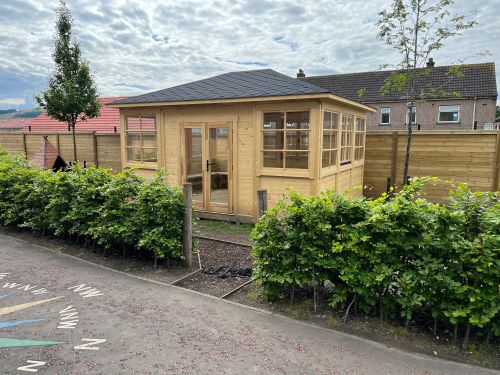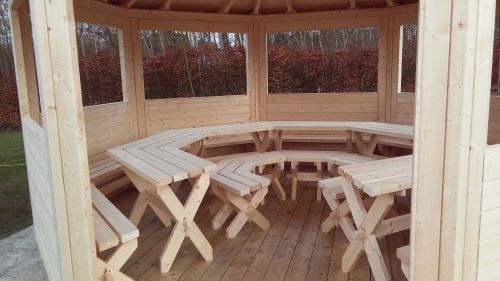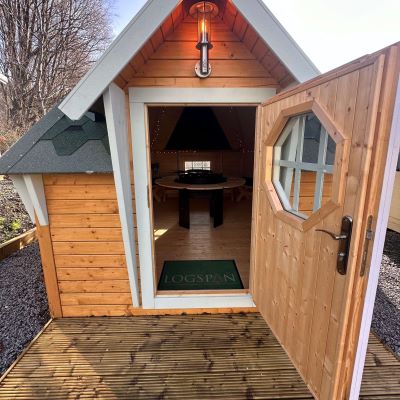Roof Preparation
The shingles should be applied once you have all the roof boards fixed down and the roof edge reinforcement and roof side boards attached to the eaves sides.
DO NOT attach the fascias, felt fillets or diamonds until after you have shingled the roof.
Black shingles are a single colour. Some non-black shingles feature a black shadow, this SHOULD NOT be covered when fitting the shingles. See Figure 0.

- Fit one side of the roof at a time.
- Start at the front of the cabin.
- Start at the eaves edge.
- Shingles and ridge should be fixed down using felt tacks/clout nails in a suitable length.
- Shingles may have a self adhesive strip on the back. You need to remove the film from before fitting, see (3) in Figure 2. You still need to nail the shingles down.
- Felt rolls may have a film on the back but this should not be removed.
- Keep any excess you cut off because you will need to reuse it later.
You can run a transluscent waterproof silicone under the shingles at the front, rear, eaves and apex of the log cabin for added protection but it is not compulsory.
Chalk lines provide visual guides that help align the shingles, horizontal lines can be snapped every 4 to 5 courses.
All chalk lines are to be considered as guiding lines not application lines.
SHINGLE APPLICATION
Proper fastening is essential for a good roof. Drive the nails straight so that the nail heads are flush with, but not cutting into the shingle surface, see Figure 1a. Always nail 2.5 cm above the cut-out and 2.5 cm from each edge. For correct positioning and nail quantities per type of shingle see Figure 1b and Figure 1c.



STARTER STRIP
You will need to create a starter strip along the eaves edge of the roof. The application process of this starter strip will depend on what you have been sold, see below.
Felt Roll
The starter strip should be approximately 33cm in width by the length of the roof, you may need to cut your full roll into strips for this process. It should fit flush to the front of the log cabin roof but overlap the eaves edge by approx 1cm. Fix down, see (3) in Figure 2.
Square shingles
Take a length of shingle, cut one of the squares off using a Stanley knife. Lay the shingle on the roof (front eaves edge). It should fit flush to the front of the log cabin roof but overlap the eaves edge by approx 1cm. Fix down, see (3) in Figure 2.
Next take a full length of shingle and lay it next to the previous one. Continue doing this until you reach the rear of the cabin. Cut off any excess shingle overhanging the rear with a Stanley knife.
Hex shingles
You will need to make rectangular lengths to work with so using a Stanley knife and ruler cut the hex bottoms off the shingle lengths to leave a rectangle.
Once you have rectangles to work with complete the starter strip the same as for square shingles above.

APPLICATION PROCEDURE (Using Figure 2)
FIRST ROW(4):
Start with a complete shingle applied flush with the starter strip. Nail as shown in Figure 6 and continue across roof with full shingles. Cut off any excess to reuse it later on.
SECOND ROW (5):
Take a full length of shingle and position it above the 1st row so that the centre of a 2nd row square fits up to the end of a 1st row square. You should have covered the nails but do not overlap the shingles too much or you will run out.
You will have some shingle excess overhanging the front and back of the log cabin, cut this off with a Stanley knife to reuse it later on.
THIRD AND SUCCEEDING ROWS (2):
Start the third row with a shingle from which a full tab has been cut. Cut off an additional half tab for each succeeding course.
FINAL ROW (Figure 3b)
Adjust the last few rows of shingles so that the ridge capping will adequately cover the top rows of shingles equally on both sides of the ridge.
RIDGE APPLICATION
You will need to create a ridge strip. The application process of this ridge strip will depend on what you have been sold, see below.
USING SHINGLES
Separate the straight or hex shingles into individual pieces by dividing the shingle at the cut- outs (1). ((A) is visual part, (B) is covered part). (Figure 3a). Depending on the type of shingle, you may be separating it into thirds or quarters. In cold weather warm the shingle before bending.
3. Start application from the end of the ridge opposite the direction of the prevailing winds. (Figure 3b). Bend a piece over the apex and nail down on both sides. Overlap the next piece on the back end of the 1st one and fix down. Nail the capping 16 cm from the tab edge (2) and 2.5 cm from each side (3). Continue until you reach the back. Do not overlap the pieces too much or you will run out.


USING A FELT ROLL
The ridge strip should be approximately 33cm in width by the length of the roof, you may need to cut your full roll into strips for this process. Starting at the front bend the roll over the apex and nail down on both sides. Run the roll to the rear of the log cabin, nail down at the back and then cut off any excess. Go back and nail down the roll along both sides at regular intervals.









